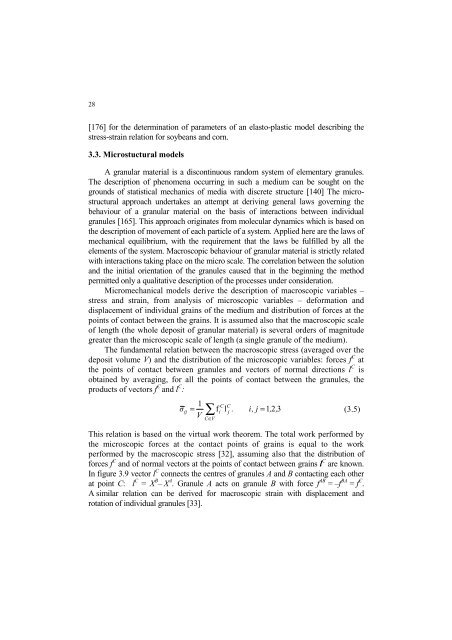Strona 2_redak - Instytut Agrofizyki im. Bohdana DobrzaÅskiego ...
Strona 2_redak - Instytut Agrofizyki im. Bohdana DobrzaÅskiego ...
Strona 2_redak - Instytut Agrofizyki im. Bohdana DobrzaÅskiego ...
You also want an ePaper? Increase the reach of your titles
YUMPU automatically turns print PDFs into web optimized ePapers that Google loves.
28<br />
[176] for the determination of parameters of an elasto-plastic model describing the<br />
stress-strain relation for soybeans and corn.<br />
3.3. Microstuctural models<br />
A granular material is a discontinuous random system of elementary granules.<br />
The description of phenomena occurring in such a medium can be sought on the<br />
grounds of statistical mechanics of media with discrete structure [140] The microstructural<br />
approach undertakes an attempt at deriving general laws governing the<br />
behaviour of a granular material on the basis of interactions between individual<br />
granules [165]. This approach originates from molecular dynamics which is based on<br />
the description of movement of each particle of a system. Applied here are the laws of<br />
mechanical equilibrium, with the requirement that the laws be fulfilled by all the<br />
elements of the system. Macroscopic behaviour of granular material is strictly related<br />
with interactions taking place on the micro scale. The correlation between the solution<br />
and the initial orientation of the granules caused that in the beginning the method<br />
permitted only a qualitative description of the processes under consideration.<br />
Micromechanical models derive the description of macroscopic variables –<br />
stress and strain, from analysis of microscopic variables – deformation and<br />
displacement of individual grains of the medium and distribution of forces at the<br />
points of contact between the grains. It is assumed also that the macroscopic scale<br />
of length (the whole deposit of granular material) is several orders of magnitude<br />
greater than the microscopic scale of length (a single granule of the medium).<br />
The fundamental relation between the macroscopic stress (averaged over the<br />
deposit volume V) and the distribution of the microscopic variables: forces f C at<br />
the points of contact between granules and vectors of normal directions l C is<br />
obtained by averaging, for all the points of contact between the granules, the<br />
products of vectors f C and l C :<br />
σ<br />
1<br />
= f<br />
V<br />
∑<br />
C C<br />
ij i l j . i, j =<br />
C∈V<br />
1,<br />
2,<br />
3<br />
(3.5)<br />
This relation is based on the virtual work theorem. The total work performed by<br />
the microscopic forces at the contact points of grains is equal to the work<br />
performed by the macroscopic stress [32], assuming also that the distribution of<br />
forces f C and of normal vectors at the points of contact between grains l C are known.<br />
In figure 3.9 vector l C connects the centres of granules A and B contacting each other<br />
at point C: l C = X B – X A . Granule A acts on granule B with force f AB = –f BA = f C .<br />
A s<strong>im</strong>ilar relation can be derived for macroscopic strain with displacement and<br />
rotation of individual granules [33].
















